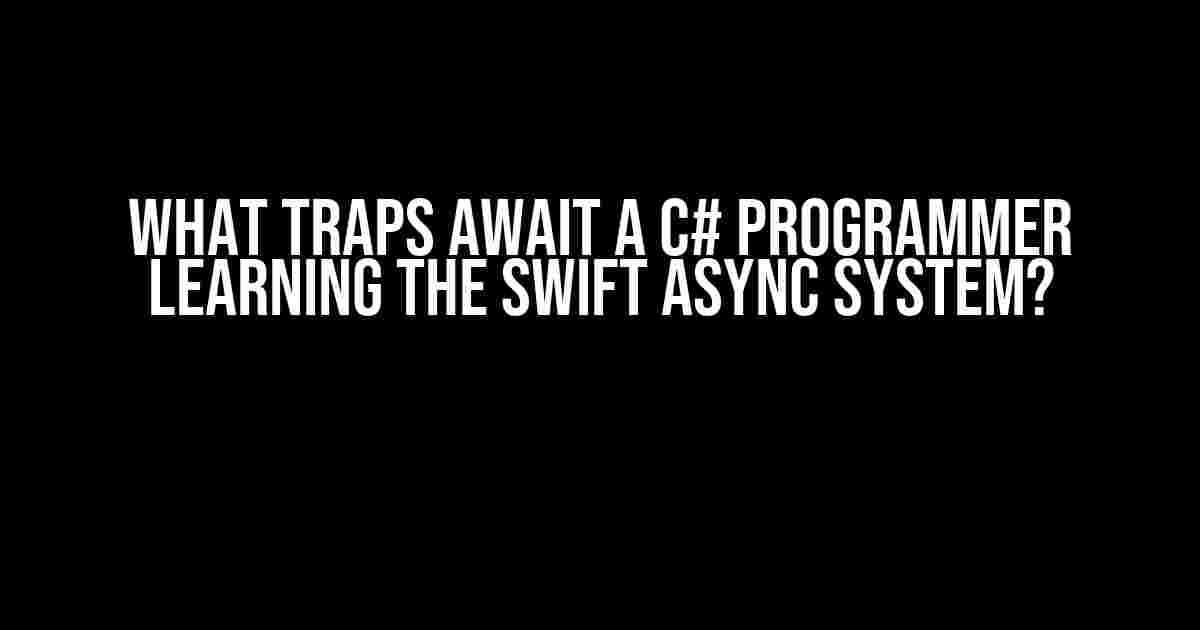As a seasoned C# programmer, you’re no stranger to the world of asynchronous programming. But, as you venture into the realm of Swift, you’ll soon discover that the async system is not exactly what you’re used to. In this article, we’ll explore the common pitfalls and traps that await a C# programmer learning the Swift async system, and provide you with a comprehensive guide to navigating these unfamiliar waters.
Theasync/await Trap
In C#, you’re probably accustomed to using the async/await pattern to write asynchronous code that reads like synchronous code. However, in Swift, the async/await pattern is not exactly the same. Swift’s async/await is more like a thin wrapper around a callback-based API, which can lead to unexpected behavior if not used correctly.
let task = URLSession.shared.dataTask(with: url) { data, response, error in
// handle the response
}
task.resume()In the above example, the dataTask function returns a task that can be resumed using the resume() method. However, if you’re not careful, you might end up writing code like this:
func fetchData(url: URL) async -> Data {
let task = URLSession.shared.dataTask(with: url) { data, response, error in
return data!
}
task.resume()
// This will not work as expected!
return await task
}This code will not work as expected because the async/await pattern in Swift is not magical. The await keyword only works within the context of an async function, and it will not block the execution of the code until the task completes. Instead, it will simply return a continuation that will be executed when the task completes.
The GCD Trap
In C#, you’re probably used to using Task.Run to run a block of code on a thread pool thread. In Swift, you might be tempted to use Grand Central Dispatch (GCD) to achieve similar results. However, GCD is a low-level API that requires a deep understanding of concurrency and thread management.
DispatchQueue.global(qos: .background).async {
// Run some code on a background thread
}While GCD can be powerful, it’s easy to get it wrong. For example, if you’re not careful, you might end up creating a retain cycle:
class MyViewController: UIViewController {
override func viewDidLoad() {
super.viewDidLoad()
DispatchQueue.global(qos: .background).async {
// This will create a retain cycle!
self.doSomething()
}
}
}To avoid this trap, it’s essential to understand how GCD works and how to use it correctly. A better approach would be to use the async/await pattern or a higher-level API like Combine.
The Closure Trap
In C#, you’re probably used to using lambda expressions to create small, one-off functions. In Swift, closures are similar, but they have some subtle differences. For example, closures in Swift can capture variables from the surrounding scope:
var count = 0
let closure = {
count += 1
print("Count is \(count)")
}
closure()
closure()
closure()This code will print “Count is 1”, “Count is 2”, and “Count is 3” because the closure captures the count variable and increments it each time it’s called. However, if you’re not careful, you might end up creating a retain cycle:
class MyViewController: UIViewController {
var closure: () -> Void = {
self.doSomething()
}
override func viewDidLoad() {
super.viewDidLoad()
closure()
}
}In this example, the closure captures the self reference, which creates a retain cycle that will prevent the view controller from being deallocated. To avoid this trap, it’s essential to understand how closures work and how to use them correctly.
TheErrorHandling Trap
In C#, you’re probably used to using try-catch blocks to handle errors. In Swift, error handling is a bit more complex. Swift has a built-in error handling system that uses the do-catch statement:
do {
try someFunctionThatMightFail()
} catch {
print("An error occurred: \(error)")
}However, Swift also has a concept called “error propagation” that allows errors to propagate up the call stack. This can be confusing if you’re not used to it:
func myFunction() async throws -> Data {
let data = try await fetchData(url)
return data
}
func fetchData(url: URL) async throws -> Data {
// Throw an error if something goes wrong
throw NSError(domain: "ErrorDomain", code: 0, userInfo: nil)
}In this example, the fetchData function throws an error, which is then propagated up the call stack to the myFunction function. However, if you’re not careful, you might end up swallowing errors or making them harder to handle:
func myFunction() async -> Data {
do {
return try await fetchData(url)
} catch {
print("An error occurred: \(error)")
// This will swallow the error and make it harder to handle!
return Data()
}
}To avoid this trap, it’s essential to understand how error handling works in Swift and how to use it correctly.
TheConcurrency Trap
In C#, you’re probably used to using threads and locks to manage concurrency. In Swift, concurrency is built into the language using async/await and actors. However, concurrency can be complex, and it’s easy to get it wrong.
actor MyActor {
var count = 0
func incrementCount() {
count += 1
}
func getCount() -> Int {
return count
}
}In this example, the MyActor class is an actor that manages a count variable. The incrementCount function increments the count, and the getCount function returns the current count. However, if you’re not careful, you might end up with concurrency issues:
let myActor = MyActor()
myActor.incrementCount()
myActor.incrementCount()
print(myActor.getCount()) // This might print 1, 2, or even 0!The problem is that the incrementCount function is not thread-safe, and the getCount function might return an outdated value. To avoid this trap, it’s essential to understand how concurrency works in Swift and how to use actors correctly.
Conclusion
Learning the Swift async system as a C# programmer can be challenging, but with practice and patience, you can master it. Remember to avoid the common pitfalls and traps, such as the async/await trap, the GCD trap, the closure trap, the error handling trap, and the concurrency trap. With this comprehensive guide, you’ll be well on your way to becoming a Swift async system expert.
| Trap | Description |
|---|---|
| The async/await trap | Misusing the async/await pattern can lead to unexpected behavior. |
| The GCD trap | Misusing Grand Central Dispatch can lead to concurrency issues and retain cycles. |
| The closure trap | Misusing closures can lead to retain cycles and unexpected behavior. |
| The error handling trap | Misusing error handling can lead to swallowed errors and harder-to-handle errors. |
| The concurrency trap | Misusing concurrency can lead to concurrency issues and data races. |
By following this guide, you’ll be able to avoid these common traps and master the Swift async system. Remember, practice makes perfect, so start coding today!
FAQs
Q: What’s the difference between async/await in C# and Swift?
A: In C#, async/await is a language feature that allows you to write asynchronous code that reads like synchronous code. In Swift, async/await is a thin wrapper around a callback-based API.
Q: When should I use GCD in Swift?
A: You should use GCD sparingly and only when you need fine-grained control over concurrency.
Q: How do I avoid retain cycles in Swift?
A: You can avoid retain cycles by using weak references, unowned references, or by carefully designing your data structures.
Q: How do I handle errors in Swift?
A: You should use the do-catch statement to handle errors, and avoid swallowing errors or making them harder to handle.
Q: What’s the best way to learn the Swift async system?
A: The best way to learn the Swift async
Frequently Asked Question
Are you a C# programmer venturing into the world of Swift async systems? Buckle up, friend, because we’ve got some crucial questions and answers to guide you through the tricky terrain ahead!
What’s the biggest misconception about async programming in Swift?
As a C# programmer, you might assume that async programming in Swift is similar to C#. Sorry to burst your bubble, but it’s not! Swift’s async system is built on top of a different architecture, so don’t assume you can simply transfer your C# knowledge and expect it to work seamlessly. Get ready to learn new concepts and paradigms.
How do I handle errors in Swift’s async system?
Error handling in Swift’s async system can be a major gotcha! Unlike C#, Swift uses a more functional programming approach, so you’ll need to get familiar with concepts like `Result` types and error propagation. Don’t worry, it’s not as daunting as it sounds – just remember to wrap your head around the idea of explicit error handling.
What’s the deal with SwiftUI and Combine?
As a C# programmer, you might not be familiar with SwiftUI and Combine, but trust us, you’ll want to get cozy with them! SwiftUI is a declarative UI framework, and Combine is a reactive programming framework. Together, they form the foundation of Swift’s async system. Take the time to learn about publishers, subscribers, and bindings – your future self will thank you.
How do I debug async code in Swift?
Debugging async code can be a nightmare, especially when coming from a synchronous background! In Swift, you’ll need to use tools like the Xcode debugger, print statements, and logging to understand the execution flow of your async code. Pro tip: use the `async Let` keyword to create a “debuggable” async context.
What are some common gotchas when working with async code in Swift?
Oh, where do we even start? From misunderstanding `async let` and `await` to forgetting to handle errors, there are plenty of traps waiting to ensnare you! Take your time to learn about the differences between `async` and `sync` functions, and don’t be afraid to ask for help when you get stuck. And remember, when in doubt, consult the official Swift documentation – it’s your best friend in this async jungle!




